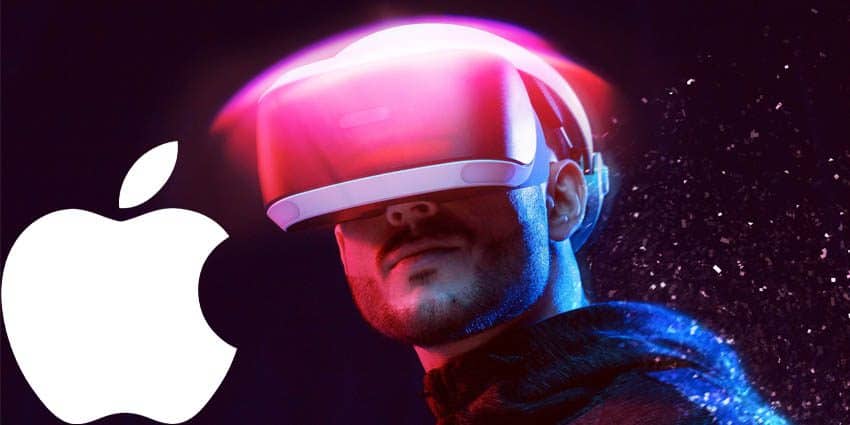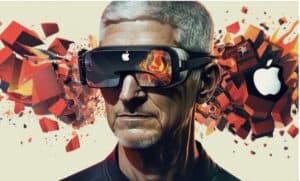There is no XR product more highly anticipated than Apple’s VR headset. Supposedly a mixed reality device, it’s seen as XR’s iPhone moment, an HMD that changes everything in immersive tech. And with each dump of rumors, the hype seems to expand beyond anything reasonable. It feels like the more people speculate about Apple’s new device, the less we actually know about their plans for the XR reality space.
Time for a reality check.
This week saw a new avalanche of rumors about Apple’s VR headset and its cutting-edge features. You can find some of our previous reports on the rumors of Apple Glasses and our earlier summary on their mixed reality device. For those of you in education and the creative arts, the latest rumors offered little about the potential impact of Apple’s forthcoming XR device on those areas.
Apple’s VR Headset Tech Spec Rumors
If you haven’t seen them already, MacRumors provides a list of the latest tech specs for the Apple VR headset:
- A waist-mounted 2-hour swappable battery pack that connects via a magnetic, MagSafe-like power cable to the headset.
- Dual Micro OLED 4K displays, with hidden outward and inward-facing cameras
- An outside display for showing the user’s facial expressions to those around them (comment: this honestly sounds creepy).
- A physical dial that enables users to transition between their virtual and physical worlds quickly (comment: an essential feature if we are going to work in both the physical world and the Metaverse).
- An option for magnetic custom prescription lenses for glasses-wearers.
- Lenses that automatically adjust to the wearer’s interpupillary distance (comment: we hope Apple does this as absolutely no one besides your eye doctor should be aware of interpupillary distance).
- A 120-degree field of view, larger than the Meta Quest Pro’s 106-degree field of view.
- Two chips, including a CPU, GPU, and memory, and a dedicated image signal processor.
- The ability to run existing iOS apps in 2D.
- The device will cost around $3,000 (comment: if true, this definitely isn’t a consumer HMD).
There’s more if you’re interested in getting all the specs with a complete account in The Information. But in truth, no one can guarantee that even the summary above is accurate.
Why None of This is Making Any Sense

The Apple VR headset rumors are all well and good. But nothing we’ve read so far sounds like a product that Apple would release. And no one is making a compelling case for why anyone besides high-end research labs need a $3,000 HMD.
Here are just a few of the questions that come up:
- Why would Apple – known for its sleek design sensibility – go with an external battery pack and cable? Even cables that don’t tether you to an external computer are a recipe for problems. Yes, battery life remains a significant issue, but even Meta pulled off an advanced HMD (the Quest Pro) without an external battery pack.
- Is the new Apple VR Headset a gaming device or not? It all depends on who you listen to in the rumor mill. Apple has never done well as a gaming platform on its own, but it generates significant revenue from the sector in the app store. We find it hard to imagine that it wouldn’t serve as a gaming platform.
- $3,000 may not be a dealbreaker, but there will be no mass adoption at that price point. Forget the arts and education; it’s unclear how many will sell in the enterprise market. Ask yourself: how many companies will start replacing their Zoom licenses with $3,000 HMDs for each employee? Especially now that the tech industry (the most likely adopters) is completely tanking with rising interest rates.
Daring Fireball sums up the absurdity of the Apple VR headset rumors we’ve seen so far:
This headset project is very much real and, I believe, very much shipping this year. But the fundamental question remains: What’s the point? Think back to Steve Jobs’s presentation announcing the original iPad — the nut of the whole keynote was Jobs explaining where the iPad might fit between an iPhone and MacBook. If it didn’t serve some tasks not just a little but a lot better than either an iPhone or Mac, there was no point to the iPad. The same is true for this headset. And if it costs $3,000 and/or requires a tethered battery strapped around your waist, the “this better be an awesome experience” bar is raised even higher.
We have to agree: Apple is not going to ship a half-baked device. And from all the rumors, we can’t discern what it will do significantly better than Apple’s current product line. And is it really enough for Apple to just produce something they could call “Better than Meta”?
We’re sure that an Apple headset is on its way and anticipate seeing it this year. But the tech press needs to take a deep breath and step back from the hype. Maybe Apple will have a surprise up its sleeve, and XR will leapfrog ahead into a new era. But the hard challenges of battery life and bandwidth make it seem unlikely that this will be XR’s iPhone moment.
Everyone needs to chill out and wait until later this year when Apple reprises the famous “One more thing” line – this time for XR.
Emory Craig is a writer, speaker, and consultant specializing in virtual reality (VR) and artificial intelligence (AI) with a rich background in art, new media, and higher education. A sought-after speaker at international conferences, he shares his unique insights on innovation and collaborates with universities, nonprofits, businesses, and international organizations to develop transformative initiatives in XR, AI, and digital ethics. Passionate about harnessing the potential of cutting-edge technologies, he explores the ethical ramifications of blending the real with the virtual, sparking meaningful conversations about the future of human experience in an increasingly interconnected world.

